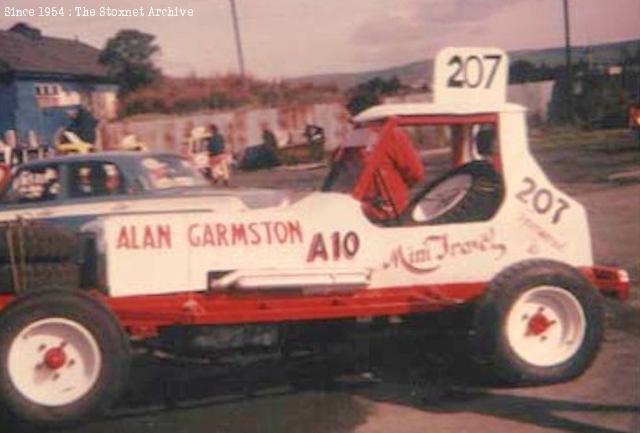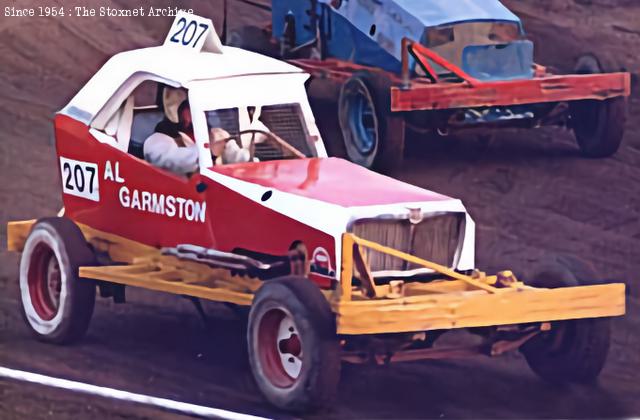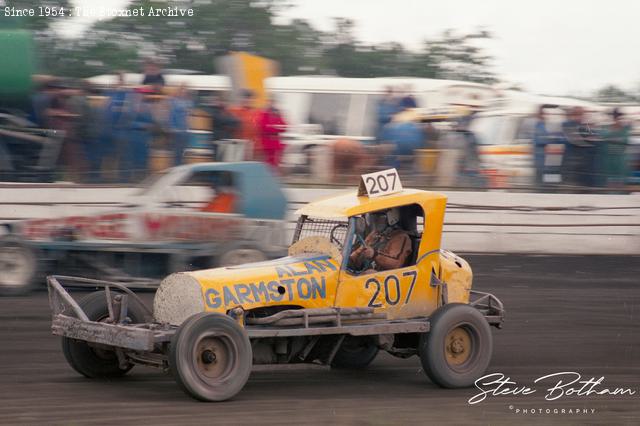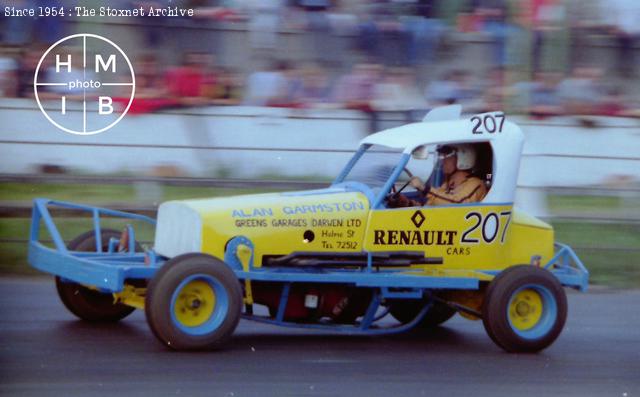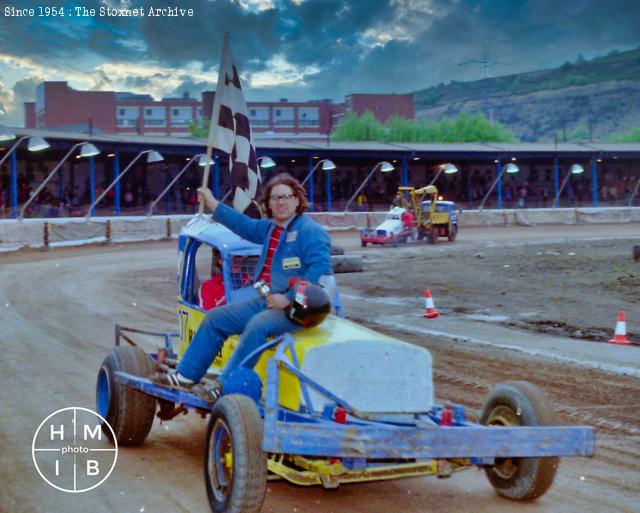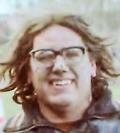
Accrington, Lancashire
207 (1975-1985)
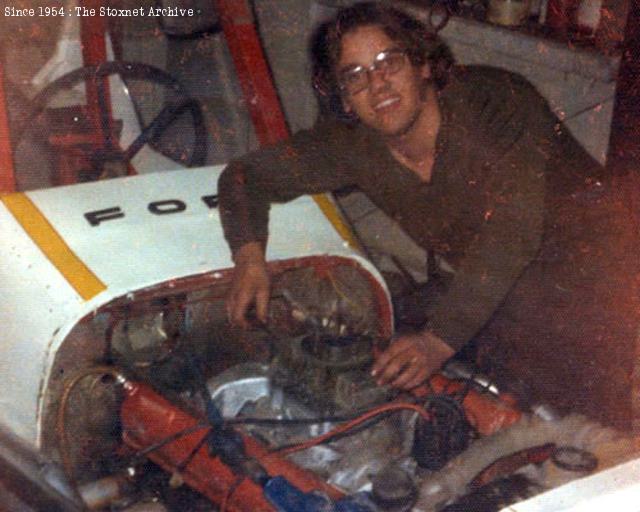
Alan’s first experience of stock car racing came at 14 years of age, when his older brother took him to Nelson for the first time. A year later, Alan started work as an apprentice motor mechanic, and on his first day the first thing he saw in the workshop was the brand new stock car of Kevin Richardson, who was the service manager. Another apprentice was the nephew of racer Eddie Fish, and it would be with a Fish built car that Alan would eventually take to the tracks. Alan’s apprenticeship included a college course that had classes on Friday evening and having skipped class one Friday evening to go to watch the racing at Rochdale, Alan bumped into another lad from his college course that had done the same thing. He was Bill Higham, and he and Alan became good friends.
When Chatburn-based driver Mac Frankland ordered a new car from Eddie Fish, Mac’s old car was offered for sale. Between them, Alan and Bill bought the car, complete with a Ford 460ci engine and four brand new Town & Country tyres for £100. The car ran, but needed re-bodying. Bill and Alan set to work, and after 12 months rebuilding the car, Alan made his debut at Rochdale one Sunday afternoon in 1975. Apart from reversing it into the garage and driving around the block in first gear, he had no experience of driving the car at all. It was a short but spectacular start to a racing career, as Alan explains.
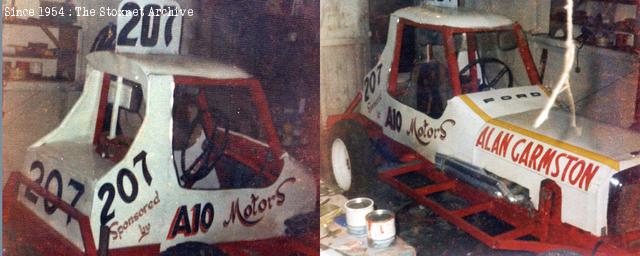
“I did approximately half a lap all meeting. I was 18 year old, I was a complete bag of nerves, I hadn’t eaten for 24 hours, basically I was shitting myself.” Although novice drivers were allowed to start at the back of the grid, Alan decided to just go for it and lined up at the front. He was one of only two white tops in the race, but he can’t remember who the other one was. Halfway around the rolling lap, he had a sudden thought, “What the hell am I doing, this is bloody stupid!”. The race started and he hit the throttle.
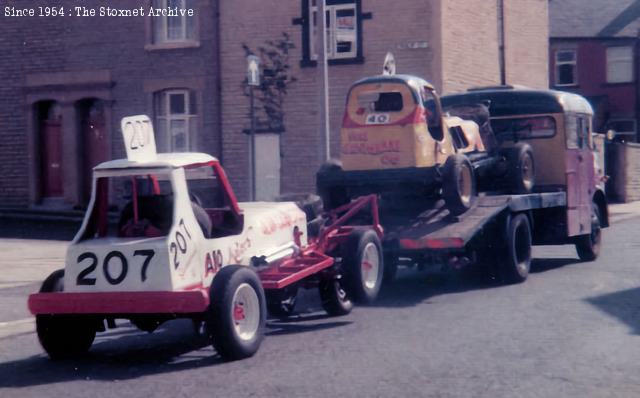
“The guy at the side of me, the other white top, set off in front of me so I pulled in at the back of him and followed him down the start straight and put him in the fence on the first corner. Then I went up the inside. All my family had come, my mum and dad, my aunties and uncles, everybody had come to watch me race for the first time".
"They said I got it in a beautiful broadside round the first bend, but never came out of it. By the time I got to the back straight I was ninety degrees to the kerb, and at Rochdale the kerb was about a foot and a half high. I hit the kerb, the stadium disappeared and all I could see was blue sky, and I landed on the rugby field in the middle.”
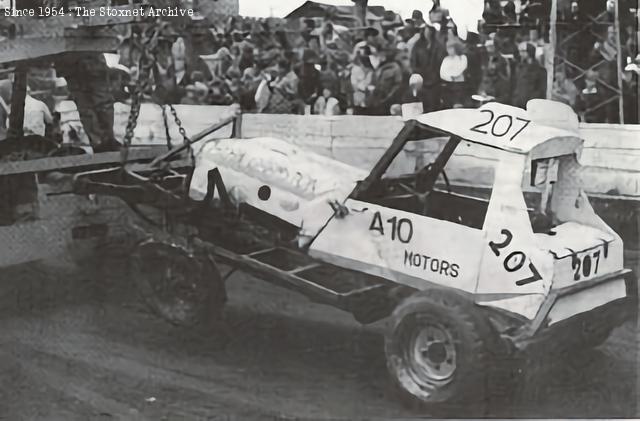
The car had broken the drop arm off the steering box, and despite having brought lots of spares, that was one thing that they didn’t have, so that was the end of Alan’s first meeting.
The Ford engine lasted about six meetings before blowing up. It wasn’t a racing engine as such, just an old engine taken from an American car. A load of engine parts were bought from Brian Wignall, from which Alan put together a 327 cubic inch small block Chevy and mated it to a Jaguar Mk X gearbox and a Bedford TK clutch. The car was raced for about 5 years, during which Alan managed a heat win at Long Eaton in 1979.
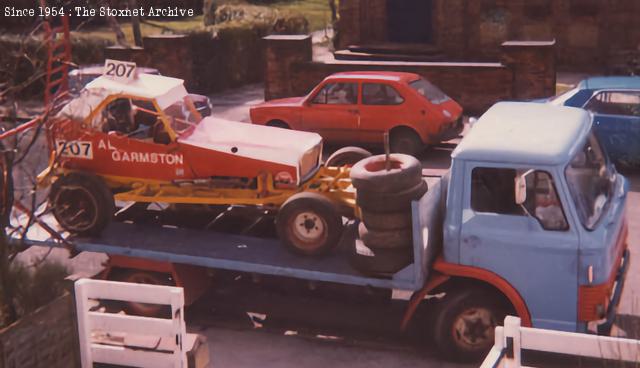
Although his dad and brother helped with the car at meetings, much of the maintenance and repair during the week was done by Alan alone, regularly working until 11pm five days a week. But he did get some help. “Brian Butterfield, he used to help sometimes, and there was another lad that used to race regularly, a young lad called Roger Brown. We were good mates and we used to help each other. It left something to be desired, did Roger’s racing but he was a very nice lad. He were a good lad, were Roger”.
They may have been mates off track, but they weren’t treated any differently on it. “Same as any other driver. It’s no holds barred once you’re out there. There’s no friendship, no love for anybody. You don’t really go out to get anybody”.

Having gone as far as he could with the ex-Fish car, Alan looked for his next car. Ray Tyldesley had just bought a car from Sam Ostle. Ray removed the engine to put in his own car, and sold the rest of the car to Alan. Fitted with a 402 cubic inch big block Chevy, purchased from local driver Brian Butterfield, Alan went on to achieve modest success with the car. The big block was taken out and replaced with an old Ford 390, which was raced for a couple of meetings until the car was sold.
Most of Alan’s success came in the last two years of his career, winning six heats and a final at Rochdale in 1984. He also came close to winning the 1982 Driver Of The Year Final, also at Rochdale. “I led for 16 out of the 20 laps. At four laps to go, I had a third of a lap lead on the second place man, but I had a wire fracture on the ignition coil. It started to misfire and slowed down. I finished fourth. The first three got trophies, fourth got nothing. I think Frankie Wainman won it, if I remember rightly, but I couldn’t be sure.”
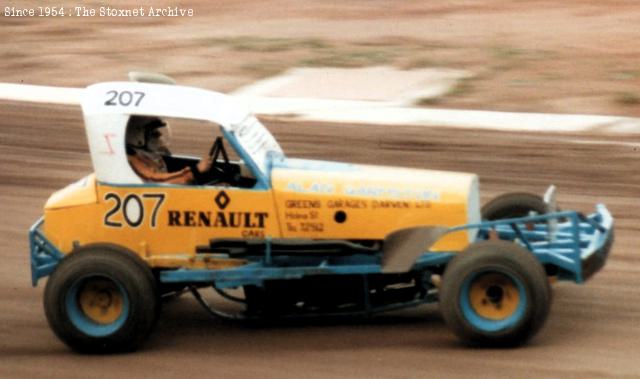
It was with a self-built car that Alan really made progress in the sport. It was designed by Alan and his friend Kevin, mainly in the grease on the bar top in The Horseload pub in Blackburn. The landlord at the time was Steve Whitworth, who had raced both F1 and F2 before taking the pub. The new car was a big improvement on previous cars. “It was like a different world, it was like the difference between driving an Austin A40 and an E-Type Jag. Because the car handled so well, the engine that I had wasn’t up to it. I was driving it on the limit all the time, particularly on the bigger tracks like Belle Vue. The car clung to the inside, you could actually steer it, it went were you wanted it to not where it wanted to go.”
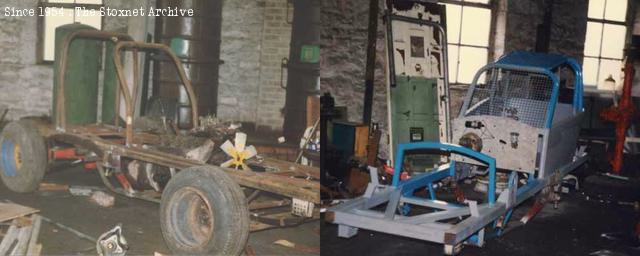
There was a major change in car construction rules for the start of the 1983 season, which meant that cars had to have three hoops in the roll cage, rather than two. As Alan rightly points out, this was the start of all stock cars being basically the same shape. The new rules meant that the traditional “three box” stock car, made up of bonnet, cab, and boot, would give way to cars with just bonnets and bigger cabs, which initially appeared to offer less room for variation.
However, Alan and Kevin wanted to keep the old three box style of car, with a boot. “We made the car with two hoops as normal then sat a smaller one behind the headrest, within six inches, slightly narrower than the chassis. There was still room to build a bootlid on the back end. There was still the three hoops and you’d got them were you wanted them. The two double hoops where over the driver’s head, which is what you wanted. We didn’t break any rules. The only other driver that kept that shape of car for a long time was Dave Berresford”.
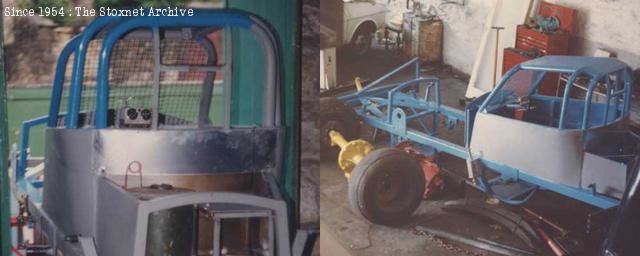
There was also some original thinking in the suspension. The car had the then usual LD axles front and rear, with semi-elliptic springs on the front. But it was at the back that things were a bit different. A lot of cars at that time were running quarter-elliptic springs, but Alan wanted the car to have softer suspension and a softer ride, and also to be easily adjustable.
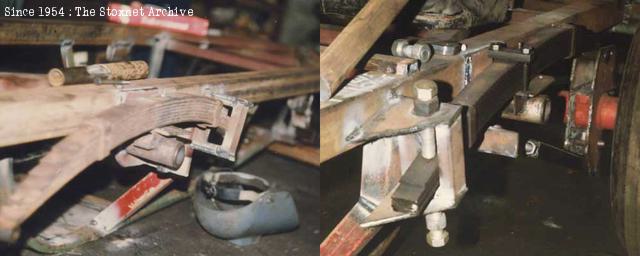
“We used a full length spring, upside down, and pivoted it in the middle so that it was on a rotating tube. The back end of the spring was anchored to the axle with a tie-bar and the front end of the spring was anchored in an adjustable bracket. So by raising or lowering the front height of the spring, it raised or lowered the height of the car.”
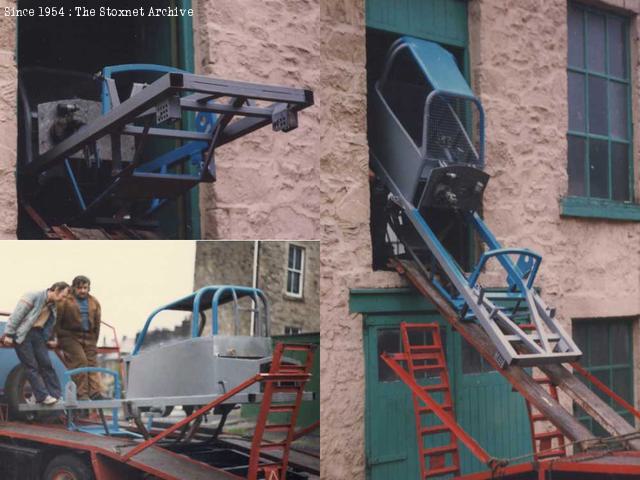
The axles were mounted onto multi-hole plates, with pins and R-clips, making it straightforward to alter the position of the axle. The car was changed from track to track, but the setup for Blackburn was different to most. “We used to run a very small, 13 inch, inside back wheel at Blackburn, cos it was a very small track. There was no top speed, the only to get any success at Blackburn was to go round the kerb. If you weren’t stuck on the kerb you weren’t going to be anywhere near".
"Because the back axle had a locked diff, if you had a 15 inch wheel on the outside and a 13 inch on the inside... it must have put some hammer on the half-shafts... but it didn’t half make it go round the corner. It drove itself round the corners. But you had a hell of a job keeping it straight going the straights!”
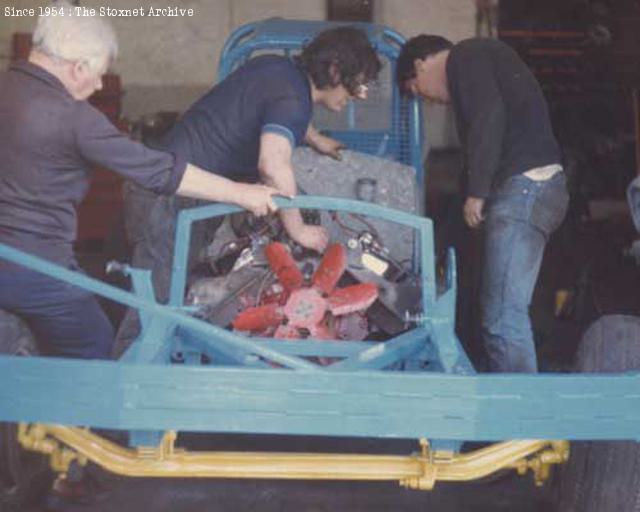
The Chevy 402 from the Ostle car was fitted to the new car after being stripped and rebuilt with new pistons, bearings, rings, a new Crane cam, high rise manifold, and a 750 Holley carburettor. It proved to be a durable engine, with Alan racing it for over 12 months with nothing more than regular oil and spark plug changes.
Unfortunately, when the engine did go wrong, it did so in a big way. “It gave up the ghost at Belle Vue. Halfway down the start straight, with my foot flat to the boards. It just went ‘bang!’. I did two 360 degree spins and ended up in the fence at the end of the start straight facing the wrong way. I jumped out, and I could see the engine oil running down off the sump guard down the shale track. There was a big puddle of oil and water down the side of the track.”
The damage was terminal. The engine had broken a con rod while at full revs, and it had completely wrecked the engine. “We salvaged the manifold, the carburettor, flywheel and the clutch, and the water pump. That was it, the rest was binned. It had smashed the heads, block and the crank and everything. The sump looked like it had been hit with a 12 bore shotgun. It was bad.”
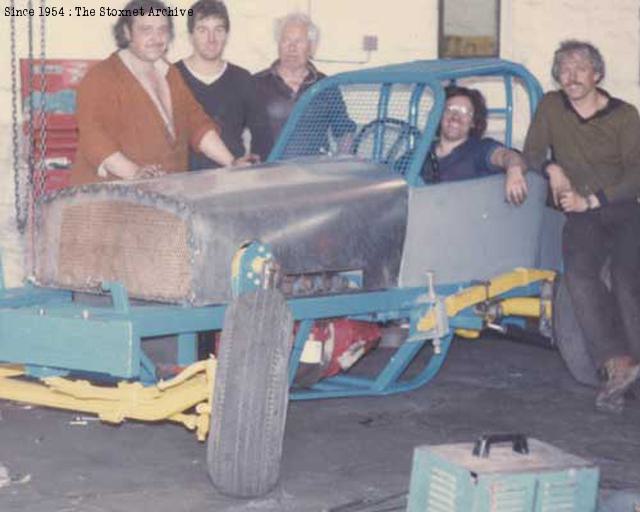
After the demise of the Chevy 402, Alan turned to a Chevy 454 that he had bought from a farmer who had intended to use it for tractor pulling, but had never got round to it. Although finances were tight and Chevy parts weren’t the cheapest, the engine was rebuilt, with new pistons, bearings, oil pump, and the crank was re-ground. The engine was raced for about a dozen meetings before it developed a very bad vibration on it at high speed. “Ticking over in the pits, it was fine, but when you were racing it the whole car had a really bad vibration on it and eventually I decided that I wasn’t going to race it anymore before it blew up.”
The engine was dismantled, but there was seemingly nothing wrong with it, so it was taken to Mike Huddart Racing Engines where a bent crankshaft was diagnosed. This marked the end of Alan’s racing career. “It had got to the stage where I couldn’t keep up with the cost. I was wanting to race Friday, Saturday, Sunday, because I’d had the taste of success, but I couldn’t afford it. I wasn’t even courting at the time so I can’t blame my wife for it but I decided to just repair the car and sell it and retire from racing.”
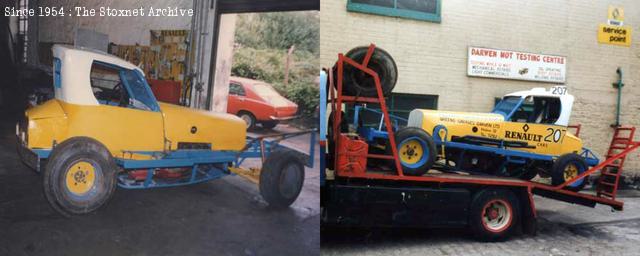
Back then, a top line Huddart prepared engine with roller rockers, cam-shafts, balanced crankshaft, TRW racing pistons would have cost around £5,000. “I couldn’t afford that, five grand was about a years wages to me in those days. Within twelve months of retiring, I had got engaged and married, and that was the end of it.”
The car was sold and eventually ended up with the late Johnny Goodhall, after initially being bought by a man from Banbury whose name Alan can’t remember. “We delivered it to Banbury for him. That was hilarious, because he lived in a semi-detached house on a nice housing estate, but there wasn’t room to get the coach down the estate to his house. So we ended up having to park the coach on the main road and drive the stock car down the estate to his house. God knows what his neighbours must have thought.”
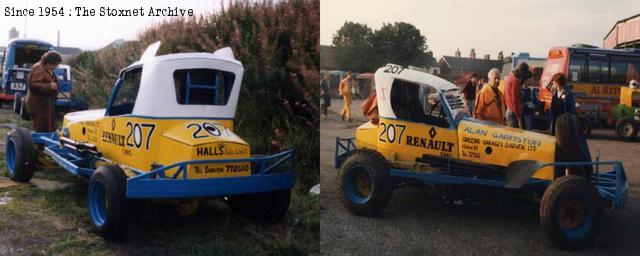
Alan had no hesitation in naming Belle Vue as his favourite track. “I always liked Belle Vue. I always had more success on shale, I could never really cope with tarmac. I just used to love Belle Vue, it really had an atmosphere. And also, it was probably one of the fastest at the time. It was a big track.” Bradford was also a big fast track, but Alan wasn’t so keen. “There was some nasty corners at Bradford when it was tarmac. On the bend opposite the pits, the inside corner used to have what everybody knew as the ski-lift. It was like a framework with steel-plating on it, at forty-five degrees to the track. So if you caught with your front wheel, you’d take off. I once hit that, and that’s the only time that I’ve been hurt while racing. I remember hitting the ski-ramp, it sent me across the track, and I hit the fence square on and I ended up on the grass in the middle. I can just barely remember somebody lifting me out of the car, and then waking up in the ambulance in the pits. They said I’d been unconscious for about ten minutes.” And did that put him off racing? “No, I played hell cos I wanted to go out in the Consolation and the doctor said “I don’t think you better had”. I was after getting in and going out again, cos no brains…”
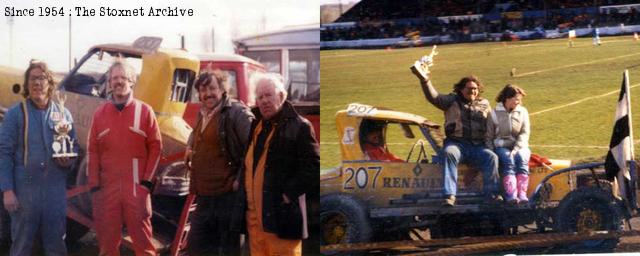
Alan named Mick Noden as his favourite driver. “I remember Willie Harrison once throwing a tyre onto the scrap pile and Mick Noden fished it out and threw it in the back of his bus. Next news he’d put it on a rim and used it. But he was one of the old brigade, one of the last of the early drivers. He raced through the seat of his pants. He didn’t go for fancy wide wheels and fancy tyres and he was just as fast as anybody else, and on standard stuff. It was just driver skill. If you’d given him a top line car he’d probably have gone even quicker. But he didn’t have a top line car, what he had was well prepared but it wasn’t anything fancy. He was just a bloody good driver. I admired him for that.”
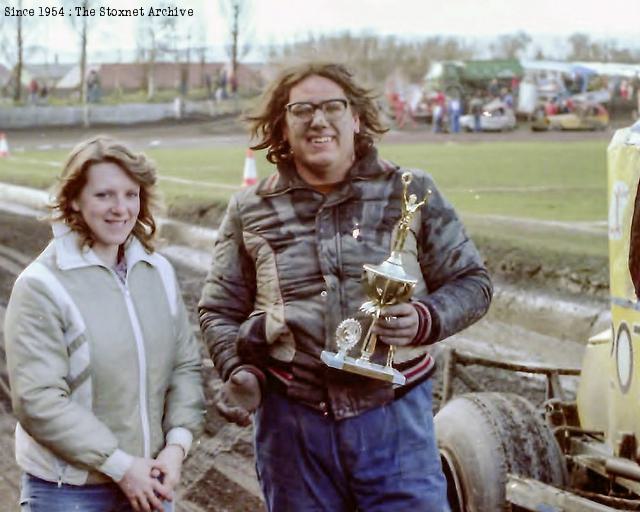
It’s now twenty years since Alan last raced. Would he still be racing today if he could afford it? “Probably, yes. It was for financial reasons that I retired, it wasn’t for any other reason. It wasn’t that I’d fallen out with stock car racing, and not because I’d been hurt, and not because I didn’t want to do it. I did want to do it, I loved it, it was my life. I couldn’t afford to have a top competitive engine and I wasn’t prepared to accept second. I couldn’t foresee any way of doing it. I’d never been able to muster any sponsorship from anywhere, so I gave it up.”
Any regrets? “I’d never any regret doing it, it was twelve years of bloody hard work but twelve years of bloody good excitement. There’s no buzz like it, the adrenaline rush that you get, particularly if you’re doing well and you’re there winning a race. I can understand why people can’t stop doing it. They just want to do it at any sort of cost, but there’s time to draw a line. It was frustrating for me cos I was bloody skint all the time. I was out in a road car with four bald tyres, and I’d be round the scrap yards for tyres for it, but I didn’t blink an eyelid at going out and buying five new RS5s for the stock car”.
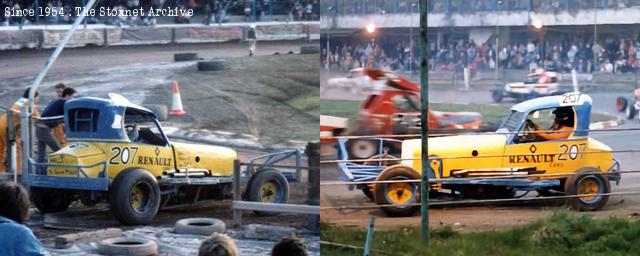
Twelve months into his retirement, Alan had a one-off outing in a borrowed car. The car had been built by John Lund for Brian Butterfield, and Alan had rebuilt a Ford 428ci Cobrajet engine for it. “I borrowed it for one meeting at Sheffield. I think I had a third in the heat and I finished the GN. I didn’t get anywhere in the Final cos I ripped the nerf rail off and didn’t finish”
But the racing bug didn’t return. “It didn’t inspire me to have another go. Now, I don’t get any kick out of going watching racing. I’m on the wrong side of the fence.”
Except where indicated, all photos are from Alan's personal collection.
| 8 race wins at 5 tracks | |
|---|---|
| Belle Vue | 2 |
| Blackburn | 2 |
| Long Eaton | 1 |
| Rochdale | 2 |
| Sheffield | 1 |
| 1. | Saturday 10th November 1979 | Long Eaton | Consolation 1 |
| 2. | Monday 3rd May 1982 | Belle Vue | Heat 1 |
| 3. | Saturday 1st October 1983 | Blackburn | Consolation |
| 4. | Saturday 15th October 1983 | Blackburn | Heat 1 |
| 5. | Saturday 29th October 1983 | Belle Vue | Heat 1 |
| 6. | Sunday 1st April 1984 | Rochdale | Final |
| 7. | Monday 21st May 1984 | Sheffield | Heat 2 |
| 8. | Sunday 3rd June 1984 | Rochdale | Heat 3 |
| 1. | 10 Nov 1979 | Long Eaton | Con |
| 2. | 3 May 1982 | Belle Vue | Ht |
| 3. | 1 Oct 1983 | Blackburn | Con |
| 4. | 15 Oct 1983 | Blackburn | Ht |
| 5. | 29 Oct 1983 | Belle Vue | Ht |
| 6. | 1 Apr 1984 | Rochdale | Final |
| 7. | 21 May 1984 | Sheffield | Ht |
| 8. | 3 Jun 1984 | Rochdale | Ht |
